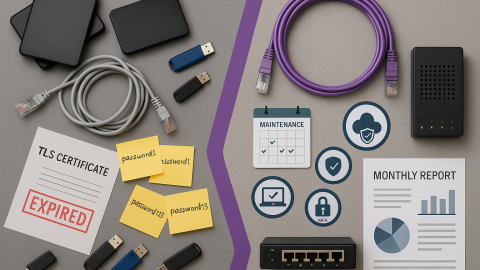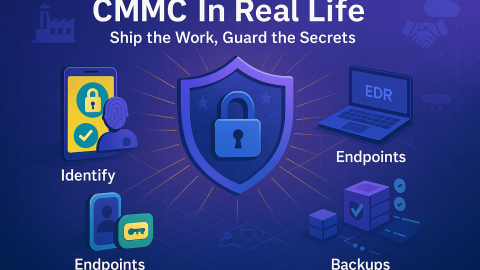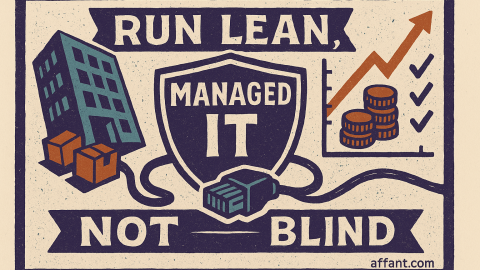You can trim headcount, freeze projects, and still watch costs creep. Licenses renew on autopilot, cloud bills drift, after-hours tickets turn into overtime, and one outage wipes out the quarter’s “savings.” Switching to an outsourced IT management partner isn’t a luxury purchase — it’s how you stop the leaks and make spend predictable.
Where the money is quietly leaking
- Zombie licenses. Extra seats and premium tiers nobody uses keep renewing.
- Cloud sprawl. Idle VMs, old snapshots, dev/test left on 24/7.
- Hero hours. Nights and weekends paid at a premium to cover routine issues.
- Break/fix tax. Unpatched systems, lapsed certificates, and “we’ll fix it later” turn into emergency POs.
- Vendor sprawl. Too many small contracts at weak rates, each expensing their own support time.
A good partner’s first 30–60 days often pays for itself by shutting these drips.
What you stop paying for when you outsource
- Owning tool stacks. Solid partners bring EDR, RMM, backup, monitoring, and patching platforms at scale. You get enterprise tools without carrying full subscriptions.
- Idle capacity. Shared after-hours coverage replaces on-call stipends and overtime.
- One-off vendors. Fewer carrier/SaaS contracts, stronger pricing, one invoice.
- Expensive emergencies. Regular patching, certificate management, and tested backups prevent the high-stress, high-cost incidents.
Predictable OpEx beats surprise CapEx
A flat, scoped monthly fee for day-to-day operations beats peaks and valleys. Projects still happen, but the baseline becomes stable — easier for finance to forecast, easier to defend at renewal.
The cost lever most teams miss: time
- Managers. No more “Where’s the laptop?” and “Who owns this vendor?” hours.
- Engineers. Fewer help-desk interruptions means more work on product and customers.
- New hires. Zero-touch onboarding turns day one into actual work, not password roulette.
- Departures. Clean offboarding releases seats and hardware — savings you can count.
Time back is money back. It also shows up as fewer missed deadlines.
What “good” outsourced management looks like (and why it’s cheaper)
Visibility that kills waste
Live inventory ties devices, apps, and licenses to owners and cost centers. Extra seats and shadow spend surface quickly — and disappear.
Standard builds, fewer tickets
A short list of approved device images and policies cuts weird edge cases. One fix can roll out everywhere. Ticket volume drops for boring, repeatable reasons.
Backups that actually restore
Immutable/offline copies plus monthly restore tests. When ransomware hits someone else, you keep shipping. Avoiding one major incident often covers the whole year.
Access with guardrails
SSO + MFA, role-based groups, and time-boxed vendor lanes. Less lateral risk means fewer costly cleanups.
A short, useful scorecard
Patch currency, EDR coverage, ticket SLA, backup restore success, license count vs. headcount, cloud spend trend. Readable in a minute, actionable by tomorrow.
How the savings typically stack up (realistic ranges)
- Licenses right-sized: 10–25% reduction in recurring SaaS spend
- Cloud hygiene: 15–30% off compute/storage with schedules and lifecycle rules
- After-hours/overtime: 50–100% reduction (replaced by shared coverage)
- Incident reduction: fewer Sev-1s; avoided emergency POs and lost productivity
- Procurement leverage: 5–15% improvement on carrier/SaaS renewals
Your mileage varies — but these buckets are where the dollars usually hide.
A quick ROI picture (napkin math)
Say you spend $85k/month across SaaS, cloud, and support.
- Trim 15% of licenses → $6.4k/mo saved
- Reduce cloud by 20% → $5.8k/mo saved
- Replace overtime with shared coverage → $4k/mo saved
- Prevent one $25k incident per quarter → $8.3k/mo averaged
That’s ~$24.5k/month back. If a managed service runs $12–15k/month, you’re still ahead — and calmer.
How to switch without drama (and keep people with you)
Start with a savings scan. Inventory licenses, cloud, overtime, and incident history. Identify the top five leaks; publish the list.
Stabilize first. Move help desk, patching, monitoring, and backups under the partner. Keep strategy in-house.
Communicate plainly. Tell staff what changes on day one: how to reach support, what “good” response times look like, and what to expect for onboarding/offboarding.
Measure in public. Share the short scorecard monthly. Show seats reclaimed, cloud trend, SLA hits/misses, and incidents avoided.
Tune, don’t thrash. Adjust scope where the numbers say it matters; leave working pieces alone.
What to keep in-house vs. what to hand off
Keep what differentiates you: product decisions, vendor strategy, industry-specific platforms. Hand off the undifferentiated heavy lifting: help desk, device care, patching, monitoring, backups, access changes, routine network work, after-hours. You set priorities; the partner provides consistent hands.
What the invoice should prove
One clean bill that mirrors your monthly review:
- Seats supported and why the number moved
- Tools included and why they exist
- Projects with clear start/finish lines
- Credits if SLAs slipped
- Savings captured since last month (licenses, cloud)
No scavenger hunt. No “gotchas.”
A short case vignette
A 220-person services firm cut headcount by 12% but saw costs rise — shadow SaaS, cloud drift, and weekend overtime. After switching to outsourced management, month one right-sized licenses (-18%) and turned off idle cloud at night (-22%). Month two replaced on-call with shared coverage and standardized laptop builds (ticket volume -27%). Month three’s review showed one avoided Sev-1 thanks to real backup tests. Net: ~$28k/month savings and a calmer support queue.
Red flags that erase savings
- “All-inclusive” until 5:01 p.m., then fees start.
- Multi-year lock-ins with no performance off-ramp.
- Forced tool stacks that satisfy partner quotas, not outcomes.
- Reports that sparkle while users still complain.
- Backups, patching, onboarding sold as “add-ons.”
If you see these, keep shopping.
Where Affant fits
Affant focuses on cost you can see and risk you can avoid. We right-size licenses and cloud, bring steady coverage so overtime fades out, standardize builds to cut tickets, and prove backups with real restores. You keep strategy and the systems that make you different. We handle the routine and the after-hours. The level of help is your call; the proof shows up on your finance report.
Bottom line: Outsourcing IT management isn’t about fewer people — it’s about fewer leaks. Kill zombie spend, tame cloud drift, prevent emergencies, and make the rest predictable. If you want a quick savings scan and a steady plan that pays for itself, Affant is ready to help.Thinking











